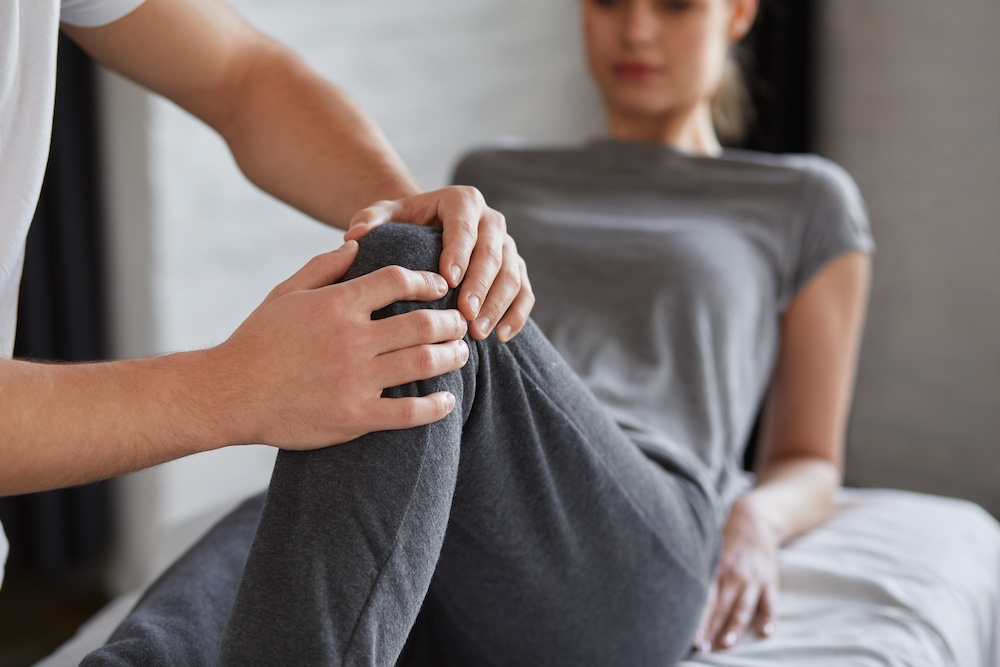[et_pb_section fb_built=”1″ _builder_version=”4.6.5″ _module_preset=”default” custom_padding=”0px||0px||true|false” hover_enabled=”0″ sticky_enabled=”0″][et_pb_row _builder_version=”4.6.5″ _module_preset=”default”][et_pb_column _builder_version=”4.6.5″ _module_preset=”default” type=”4_4″][et_pb_text _builder_version=”4.6.5″ _module_preset=”default” hover_enabled=”0″ sticky_enabled=”0″]
Whether you’re an active runner, play recreational sports, or just tweaked something in your lower leg, plantar fasciitis is no joke. It’s painful and can prevent you from doing some of your favourite activities. And worse, not many people are clear on how to treat it once it develops.
Remedies like plantar fasciitis massage can help, but understanding what is going on will help you monitor your symptoms and get back to your normal self as quickly as possible.
In this article, we’ll look at what causes that dull pain across the bottom of your foot, along with some remedies to get back to one hundred percent.
What Is Plantar Fasciitis?
Simply put, plantar fasciitis is characterised by pain in the bottom of your foot, particularly near or on your heel. Fascia is a thick ligament that engulfs your body’s muscles (if you’ve ever used a foam roller that’s fascia that you’re loosening up). The plantar fascia is located on the bottom of your foot and connect your heel to the front of your foot.
What’s it’s job? To protect your foot! There are 26 bones, some of which are tiny, in your feet, and they support your whole body when you walk, run, or go about your daily life.
When that fascia gets worn down or inflamed, due to overuse or other causes, you start to experience pain.
The worst part about plantar fasciitis is that continuing to use your feet can exacerbate your symptoms—but since it’s on the bottom of your feet, it’s pretty hard to rest completely.
Now, let’s look at some forms of plantar fasciitis treatment.
1. Plantar Fasciitis Massage
Massage is a proven way to increase blood flow to damaged tissues, loosen up muscles, and help speed up the healing process.
Plantar fasciitis is usually caused by repetitive use, which causes your muscles to get tight and start feeling uncomfortable. Using lower body massage tools, your hands, or a hardball (tennis or lacrosse balls are great) to break up some of this tension can help reduce pain.
Ease into your massage treatment, though. While it might help break up lesions, going too hard too fast might leave your foot muscles more tender than when you started.
2. Try Plantar Fasciitis Exercises
A few well-planned foot exercises can help strengthen the muscles, joints, and ligaments surrounding the fascia on the bottom of your foot. The stronger this area is, the more protected it will be from an injury.
Keep in mind: if your plantar fasciitis is already really bad, you will also want to ease into these exercises. Too much, too soon won’t be good for your recovery.
Here are a few exercises and stretches you can try:
- Calf stretch: Place your foot (closer to the toes/mid foot) on a stair, then lean forward feeling a stretch down the back of your leg. You can also do this in a plank position by pressing your heel to the floor, or with your foot up against the wall.
- Alphabet: Try drawing the alphabet with your big toe as the “pen”. This will strengthen your ankles and help improve range of motion in your feet and ankle joint.
- Toe Curls w/ Towel: From a seated position, wrap a towel around your foot. Using the resistance of your hand tugging on both ends of the towel, gently press your ankle forward to the end of your range of motion. Go back slowly. Repeat 5 to 10 times.
Low-impact cardio exercises, like swimming or biking, help increase blood flow to your entire body, which promotes healing. Running or walking, if it’s painful, should probably be limited or avoided.
3. Get New Shoes (Or Go Barefoot)
You wouldn’t be the first person to cure your PF with a pair of new shoes. Over time, the support of our shoes wear down, sometimes putting the foot in a compromising position. The overuse injury your foot is experiencing may be because your foot is sitting in a less-than-optimal location in the shoe.
You can also try walking short distances barefoot. (By short, we mean 200 to 400 meters, preferably on a natural surface like grass, then working your way up from there.)
It may seem counterintuitive, but the direct contact with the ground forces the small muscles and joints in your feet to bear a load they don’t normally have to with shoes on.
4. Ice The Affected Area
The NHS also recommends icing for treating your plantar fasciitis. Ice reduces swelling, which is a common side-effect of inflammation in the body.
Avoid icing for more than 20 minutes at a time, and give yourself a few hours in between sessions to avoid skin irritation.
5. See A Doctor
The internet is a great place to get general advice about your plantar fasciitis. But if your symptoms are serious, or the pain hasn’t subsided for several weeks, it’s probably best to see a doctor.
They can refer you to a specialist, and you can get a more accurate diagnosis that takes into account your foot shape and any limitations you have regarding exercise.
Plantar Fasciitis: Wrap Up
If you’re dealing with plantar fasciitis, you know the injury is no joke. Pain on the bottom of your heels can be hard to deal with, especially if you lead an active life or spend a lot of your day on your feet at work.
To reduce your symptoms, try a plantar fasciitis massage, exercises, new shoes, and ice. If things don’t get better, make an appointment with your doctor.
If you’re in the market for a massage tool to reduce your symptoms, check out our products. We hope your PF gets better soon!
[/et_pb_text][/et_pb_column][/et_pb_row][/et_pb_section]




